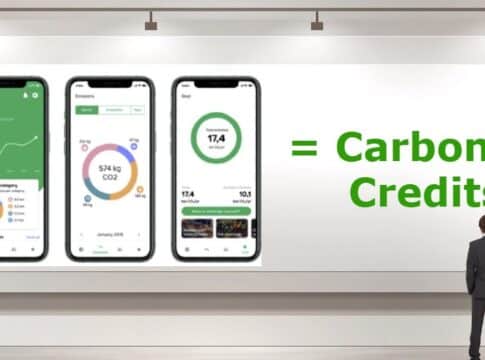How to Calculate Carbon Credits? (5 Easy Steps to Follow)
Carbon credits are vital components of global emissions trading strategies to lower emissions and global warming. But not everyone knows how to calculate carbon credits and price them.
If you’re one of those wondering how carbon credits are calculated, then this article will guide you through from start to finish.
It will help you know the steps detailing how carbon credits are calculated, the importance of accounting them and how to measure the credits you need to offset your emissions. This is even more important if you are so eager to reduce your own carbon footprint and compensate for it well.
How To Calculate Carbon Credits
A carbon credit is a unit of exchange that individuals and firms alike use to offset their greenhouse gas (GHG) emissions.
One carbon credit, or offset in the voluntary carbon market (VCM), is equal to one metric tonne of GHG reduced or avoided from entering the atmosphere.
Carbon credits don’t have the same value. This is mainly because the carbon credit market, like any other voluntary markets, are not regulated. Different factors affect the final value or price of the credit.
Market dynamics or the supply and demand, project costs and location, and the project developer all impact how much is the worth of each credit. So the results of measuring and accounting for carbon credits can vary a lot, depending on those factors.
Accounting for carbon credits also varies for personal and business purposes.
On the individual level, home energy use, travels, meals, and hotel stays are the key items to factor in when calculating emissions. For businesses, the entire value chain of the products or services offered must be taken into account. Plus, employees’ travel and commute.
The total tonnes of emissions calculated determine the amount of carbon credits you need to offset your footprint.
How Are Carbon Credits Calculated?
There are five easy steps to follow on how to calculate carbon credits you have to buy for offsetting emissions according to DEFRA.
It refers to the Department for Environment, Food and Rural Affairs in the UK. But in general, the steps for calculating carbon footprint to know the corresponding offsets are the same from country to country and here’s how to do that.
Step #1: Determine activities that emit GHGs
The first thing you should do is to identify activities you or your firm do that release GHGs.
The more complex the structure of your organization, the more difficult it is to identify who or what are the sources of emissions. But most often, doing it involves three different ways based on the following emissions scopes.
The following diagram shows the common types of emissions sources under each scope.
Identifying those activities under each of the 3 scopes will be helpful when targeting the emissions source for later reductions.
Step #2: Quantify polluting activities
The most common approach used to calculate GHG emissions is to apply emission factors to known activity data from your home or organization.
This means getting the quantity of resource use through receipts, invoices, or bills associated with the activities. For instance, calculate the amount of electricity, fuels, goods, and services you paid for.
Activity data can be collected in different units of measurement. For example, weights in the case of food or volume for fuel used and kilowatt hours for electricity consumed.
For water, you quantify emissions in cubic meters while it’s mileage for travel. The costs for each of these polluting activities should be monitored and summed up for each year.
It is best to collect activity data by volume or mass (e.g. liters of petrol) as emissions can be measured more accurately.
The table below sets out common polluting activities and sources of information to turn the data into GHG emissions.
And if it’s impossible for you to calculate emissions from known activity data, you can estimate. But be transparent of the estimation method used to ensure that results are reasonable.
Step #3: Get the emission factor of major GHGs
This is when things can be quite tricky as to how carbon credits are calculated. That’s because there’s a formula to get the emissions from all six major GHGs. But keep in mind that your reporting period should be for 12 months.
Your emissions year should also ideally correspond with your financial year. In case they’re different, most of your reporting year must fall within your financial year.
Going back to the DEFRA guide, it notes that different activities or fuels also have different emission factors (EF). That’s to reflect how polluting each of the following GHGs is:
Carbon dioxide (CO2),
Methane (CH4),
Nitrous oxide (N2O),
Hydrofluorocarbons (HFCs),
Perfluorocarbons (PFCs), and
Sulfur hexafluoride (SF6).
Different activities and fuel can release one or more of them. So, it’s important that you know their corresponding EF. To calculate emissions of each GHG, here’s the formula to follow:
“Activity data x Emission factor = GHG emission”
Activity data refers to total use of a resource in a year. Multiplied that by the EF of all the GHGs generated by that certain activity and you get the emissions.
The Environment Protection Agency (EPA) Greenhouse Emission Inventories provide the EFs for various fuels/resources. These include coal and coke, biomass, electricity, fossil fuels, natural gas, and petroleum.
You can also find the EF of GHGs per type of vehicle that you or your company use and corresponding year.
The EPA also keeps a record of EFs for various industries called AP-42. It contains EFs of over 200 air pollution source categories, industry sectors or groups of similar emitting sources.
For the EFs of the foods and drinks you consume, you can find them in this Intergovernmental Panel on Climate Change (IPCC) Guidelines for National Greenhouse Gas Inventories.
Step #4: Change the EF to carbon dioxide equivalent
One crucial thing to take note is that the 6 major GHGs don’t have equal damage to the planet, also called their Global Warming Potential (GWP).
In other words, one unit of CO2, for instance, has a different warming effect than methane. It’s the same for the other GHGs.
Likewise, one unit of nitrous oxide has a GWP of 298 or equal to 298 units of CO2. It means N2O has the potential to warm the earth 298x more than the same amount of CO2.
That’s why it’s important to convert emissions into CO2 equivalent (CO2e). To do this, multiply the EF of each GHG with its corresponding GWP.
Step #5: Compute total emissions
The last step left to do is to calculate the total emissions of your activities/resource use. Get it by summing up all emissions in CO2e for a year.
For personal emissions, there’s another way to get your carbon footprint. For instance, you can use an online calculator that can generate your total emissions after you provide all the information.
But if you prefer a manual calculation for your organization’s emissions, you can always follow the five easy steps mentioned.
Sample computation to calculate carbon credits
The steps serve as a guide on how carbon credits are calculated. To give you a clearer picture, here’s a sample calculation you can try.
It’s based on electricity use of a household with four persons living in the U.S. The basis is the known 2015 activity data.
Step 1: Electricity use is under Scope 1 emissions
Step 2: Average use of electricity by 1 person in the US is 4,517 kWh/year.
So, it means the household of 4 people uses about 18,068 kWh (kilowatt per hour). That is equal to around 18 MWh of electricity use. 1,000 kWh = 1 megawatt (MWh).
The next step is to calculate the emissions for the activity by getting its EF.
Step 3: Electricity use EF from the EPA Greenhouse Emission Inventories
Get the EFs for electricity from the EPA Greenhouse Emission Inventories. You’ll find three GHGs for this – CO2, CH4, and N2O. Here’s the corresponding EFs for each one of them:
CO2/MWh = 650.31 lbs
CH4/MWh = 0.03112 lbs
N2O/MWh = 0.00567 lbs
Following the formula provided earlier, multiply the 3 EFs above by 18 MWh of electricity used by the household of 4. The computation to calculate total emissions for a year goes as follows:
650.31 lbs (CO2) x 18 = 11,705.58 lbs of CO2
0.03112 lbs (CH4) x 18 = 0.56016 lbs of CH4
0.00567 lbs (N2O) x 18 = 0.10206 lbs of N2O
Step 4: Converted CO2e for CH4 and N2O
To express all the emissions in CO2e, multiply their GWP specified in the EPA Greenhouse Emission Inventories.
In this case, the methane (25) and nitrous oxide (298) GWPs as explained earlier. The calculation goes like this:
11,705.58 lbs of CO2 x 1 = 11,705.58 lbs of CO2e
0.56016 lbs of CH4 x 25 = 14.00 lbs of CO2e
0.10206 lbs of N2O x 298 = 30.41 lbs of CO2e
Step 5: Total emissions is 11,750 lbs of CO2e
Lastly, sum up all the 3 converted emissions from step 4 above. Then you’ll arrive at around 11,750 lbs of total CO2e emitted in a year for electricity consumption of 4 people.
Carbon emissions often come in tonnes. So 11,750 pounds is equal to about 5.33 tonnes of CO2e.
So, what does that figure mean to calculate the carbon credits you have to buy? It’s pretty simple. Just multiply the total emissions (5.33) with the price of carbon per tonne as per the market’s rate.
For example, if the carbon price in the market that you buy from is at US$15.0/tCO2e, that would be: 5.33 tCO2e x $15.0 = $79.95.
So, the family of four wanting to offset their emission due to electricity use can buy carbon credits worth $79.95. Or it can be lower depending on the certain market they’ll be buying from.
That money is then spent on projects that reduce or avoid carbon from entering the atmosphere.
Accounting For Carbon Credits
High CO2 emitting sectors like the energy, aviation, and automobile are under regulatory or compliance carbon credit schemes. It means they have to meet a certain limit on emissions set by a government regulatory framework.
This is also called the cap-and-trade scheme or Emissions Trading System (ETS). These systems create the Certified Emissions Reduction (CER) credits. Firms with excess CER credits can trade with others who are over their limits.
There are some key international accounting bodies for regulatory carbon credits after the Kyoto Protocol. But since there’s no regulatory guidance yet, some firms made their own emissions accounting policies. But most companies are accounting for their carbon credit transactions using the IASB’s IFRS.
You can also buy carbon credits from a voluntary carbon project, also known as carbon offsets. The steps involved when accounting for carbon credits under VCM are identical, but only without the regulatory approving bodies.
Still, a third-party entity must verify the carbon credits created by the project. This is to ensure that the amount of reductions they claim are verifiable and real or measurable.
How To Assess or Measure Carbon Credits?
A project’s emission reductions represented by carbon credits are measured in tonnes of CO2e reduced or removed from the atmosphere. How to measure these carbon credits involves considering a set of key criteria.
A project’s emission reductions represented by carbon credits are measured in tonnes of CO2e reduced or removed from the atmosphere. How to measure these carbon credits involves considering a set of key criteria.
Though each credit represents one tonne of emission reduction, not all carbon credits are created equal and so their prices also vary. In general, there are three criteria that you can use to guide your buying decision – additionality, permanence, and measurability.
Additionality: a carbon reduction or removal is “additional” if it would not have happened without the carbon credit.
Additionality is crucial when evaluating or measuring carbon credits to buy. It affects the quality of a particular carbon credit. This is because buying credits to offset your emissions may only worsen the climate if the reductions are not additional. By definition, most carbon removal credits have high additionality as they rely on carbon credits to work.
Permanence: this refers to the duration and risk of leakage of carbon reduction or removal project.
This criterion considers the fact that most CO2 emitted today will not be 100% removed later. Only 25% of it stays in the air for over a hundred years.
And so, high-quality credits are the ones that go with reductions/removals that are permanent. >100 years is permanent and below that is temporary.
Measurability: this deals with data availability and verification.
The reported emission reductions must be accurate and verifiable. In particular, overestimation of GHG reductions should not occur. Otherwise, the measurability of the data won’t be reliable.
Projects that have no data to verify have poor measurability while those with verified data have good measurability.
Pricing Carbon Credits
In regulated carbon markets like the case of the EU ETS, the regulation influences the price setting. But in the VCM, prices vary based on project location, carbon program, and market conditions.
Carbon credits prices also differ depending on the specific type of projects that generate them.
For instance, carbon credits from wind projects in India (which are abundant) have an average price of $1.2/tonne. In comparison, carbon credits from the same project type in the US (which is not common) cost about $3.7/tonne.
Also, the carbon program Gold Standard often prices carbon credits higher than others. That’s because it includes in the price the social costs of the credits used for offsetting emissions.
You can learn more about carbon pricing in this comprehensive guide.
How Do You Calculate Carbon Credits? – Key Takeaways
Carbon credits put a price on air pollution. They serve as a currency used by entities to pay for their emissions.
Carbon credits are available either in compliance or voluntary carbon markets. Though prices and standards vary between these markets, carbon credits still play the same vital role in preventing or reducing emissions.
Most importantly, measuring your own emissions to calculate the carbon credits needed to offset them is one way you can help to save the planet from damaging effects of the climate.
So, if you’re ready to do it, you can start by following the 5 easy steps discussed on how to calculate carbon credits. Then you can begin searching for the best carbon offset programs to consider.
The post How to Calculate Carbon Credits? (5 Easy Steps to Follow) appeared first on Carbon Credits.



